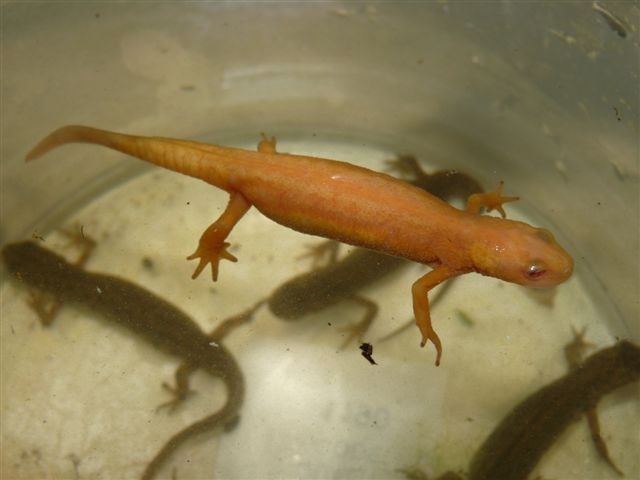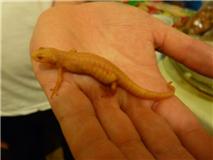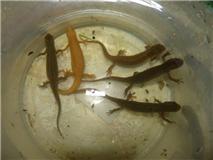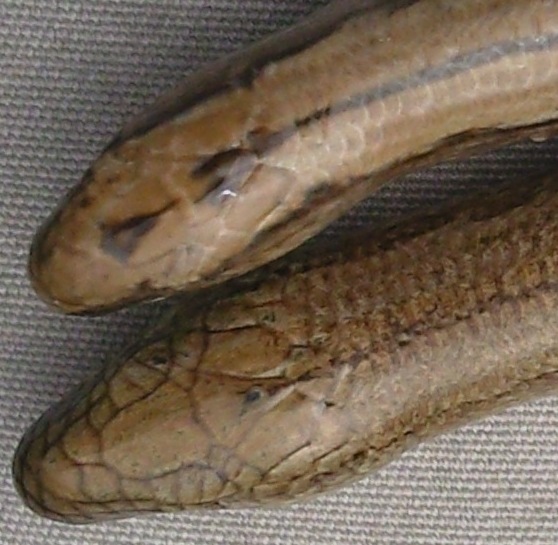 |
 |
albino smooth newt: |
| Author | Message |
|
will Senior Member Joined: 27 Feb 2007 No. of posts: 330 View other posts by will |
Posted: 10 Mar 2011 Hi all I mentioned an albino smooth newt had been spotted in a garden pond which also had a population of some albino toads last year; just got this photo of it from this spring courtesy of Steve Pash, a naturalist based in the vicinity of the pond, which is in Ruislip, North-West London. Still curious as to why the same pond has two species showing albinism - also it's an unusual smooth newt as most albinos also still have gills - suggesting a thyroid problem. This one seems to be a 'true' adult. Curiouser and curiouser... Cheers Will  |
|
will Senior Member Joined: 27 Feb 2007 No. of posts: 330 View other posts by will |
Posted: 11 Mar 2011 a couple more I've been sent of the same animal; the one in the hand looks almost golden   |
|
ben rigsby Senior Member Joined: 27 Apr 2010 No. of posts: 337 View other posts by ben rigsby |
Posted: 23 Mar 2011 great find and pix will. ive read about this (or certainly a similar home counties) garden pond before. a few years ago there was an article/pix in the BHS journal on its toad and newt albinos. sorry, no i cant direct you to it. i only borrowed the publication from a mate. unusual occurrence isnt it? i wouldnt know whats driving it though! 
if it IS the same pond, are the nos of albinos increasing i wonder? thanks a lot for posting this very interesting item! 
ben Diversity. |
|
will Senior Member Joined: 27 Feb 2007 No. of posts: 330 View other posts by will |
Posted: 24 Mar 2011 Cheers Ben - I guess the BHS journal could have been referring to the same pond. I'll see if I can track it down. |
|
Scale Senior Member Joined: 05 Dec 2010 No. of posts: 83  View other posts by Scale |
Posted: 25 Mar 2011 Hi will, I have seen this a couple of times in Great Crested Newts before; the newts being pale cream/orange with a more pronounced orange dorsal stripe and a slight 'transparency' to the skin. Your Smooth newt (in hand) looks identical in colouration to the GCNs I've seen. They are thought to be amelanistic (or lacking the ability to produce melanin pigments). It is generally considered to be genetic but may also be environmental or chemical (pollution). Thus your two in one pond, the question is which. As with true albinism in Smooth newts you would expect to see signs of neoteny due (as you say) to the corruption of the glands associated with thyroxine production. Either way rare and/or perhaps localised in origin Cheers Rob |
|
Scale Senior Member Joined: 05 Dec 2010 No. of posts: 83  View other posts by Scale |
Posted: 25 Mar 2011 P.S. red frogs are generally considered amelanistic and this is associated with inbreeding and genetic isolation (as i'm sure you know). This may be worth consideration if an urban/isolated population of newts...Just a possible theory, don't roast me for it  |
|
Caleb Forum Coordinator Joined: 17 Feb 2003 No. of posts: 448 View other posts by Caleb |
Posted: 25 Mar 2011 [QUOTE=Scale]As with true albinism in Smooth newts you would expect to see signs of neoteny due (as you say) to the corruption of the glands associated with thyroxine production. [/QUOTE] This is not necessarily the case. Impaired pineal gland function does lead to neoteny and lack of melanin, but either is possible without the other; there are quite a few photos around of metamorphosed albino smooth newts, and plenty of records of normally coloured neotenous newts. The yellow colour doesn't necessarily mean it's not a 'true' albino, as a lot of the yellow pigments in amphibian skin accumulate via carotenoids in their diet. |
|
GemmaJF Admin Group Joined: 25 Jan 2003 No. of posts: 2090 View other posts by GemmaJF |
Posted: 25 Mar 2011 [QUOTE=Scale]P.S. red frogs are generally considered amelanistic and this is associated with inbreeding and genetic isolation (as i'm sure you know). This may be worth consideration if an urban/isolated population of newts...Just a possible theory, don't roast me for it  [/QUOTE] [/QUOTE]Have you got a reference for this? I've been saying for years red frogs were not a good sign in a population, I simply never saw them back in the 70's when frogs actually were 'common' Gemma Fairchild, Independent Ecological Consultant |
|
Scale Senior Member Joined: 05 Dec 2010 No. of posts: 83  View other posts by Scale |
Posted: 25 Mar 2011 Gemma, I'm not sure where i saw it. It must have been in a well known publication as i thought it was common knowledge. Likely one of the several Amphibian and Reptile of Britain books or T Beebees book on Frogs and Toads. I'll keep my eyes peeled and let you know if i find it. Caleb, i'm glad you told be that. I had felt that either should be possible (i'm certainly no expert on the subject). What are your thoughts on amelanism in newts? Have you heard of albinism in GCNs? because i have seen what i would call amelanism in two specimens (both looked similar to Will's newt). As the man in the orthopedic shoe said: 'I stand corrected' Cheers |
|
Caleb Forum Coordinator Joined: 17 Feb 2003 No. of posts: 448 View other posts by Caleb |
Posted: 26 Mar 2011 There's a photo of what's described as an 'albino' crested newt in Pat Wisniewski's book on the British newts- it looks much like the smooth newt pictured here. It's a bit difficult to say whether amelanism in newts is different from albinism. The term 'albino' was first applied to mammals, and as the vast majority of mammal colouration comes from melanin, most mammals lacking melanin will look pure white. The classic 'albino' trait in mammals is the lack of a gene that produces tyrosinase, an enzyme that's necessary for melanin production. In amphibians, as well as melanin (black or brown) it's common to have yellow/orange/red pigments (carotenoids or pterins) and microscopic structures that reflect blue light by interference. The blood beneath the skin can also give pink or bluish colours. So if melanin is lacking, these other pigments will determine the appearance of the animal- any species which has these in small amounts will appear white or pale pink; any species which has these in large amounts might still be quite brightly coloured. |
|
Scale Senior Member Joined: 05 Dec 2010 No. of posts: 83  View other posts by Scale |
Posted: 26 Mar 2011 [QUOTE=Caleb] In amphibians, as well as melanin (black or brown) it's common to have yellow/orange/red pigments. [/QUOTE] That was my understanding of what amelanism was (lacking brown and black [melanin] but exhibiting other pigments), although i also recognise that true 'albinos' will often exhibit pigments accumulated from external sources during adult development(particularly yellow). Elsevier's dictionary of herpetological terms cites the very same. My understanding of true albinism is a lack of all pigments at birth(pink from the blood vessels being the only 'colour' exception)? I'll have a look at that book you mentioned. Many thanks for this Rob |
|
will Senior Member Joined: 27 Feb 2007 No. of posts: 330 View other posts by will |
Posted: 27 Mar 2011 Wow! thanks for all the conjectures folks! At any rate, whether it's albino or amelanistic it's a nice looking animal and the red eye suggests there's no dark pigment production I suppose. I found out that the BHS article was about this very pond; also that albino toads had been recorded around twenty years ago in a pond just around the corner from the current location, so it's a situation with some history. I have argued that 'odd coloured' amphibians in garden pond situations may be to do with enhanced survival chances in the sheltered environment of gardens rather than in the Darwinian school of hard knocks out there in the wild. This wouldn't exclude the possibility of inbreeding producing more animals exhibiting colour variants in the first place, but equally a reduction in selection against brightly coloured morphs could heighten this phenomenon. |
|
Scale Senior Member Joined: 05 Dec 2010 No. of posts: 83  View other posts by Scale |
Posted: 27 Mar 2011 excellent stuff  |
|
JamesM Member Joined: 12 Mar 2011 No. of posts: 43 View other posts by JamesM |
Posted: 27 Mar 2011 That is interesting. I didn't think Albinism occured in Amphibians! |
- albino smooth newt |